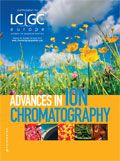Ion Chromatography: Yesterday, Today, and Tomorrow
Special Issues
A brief introduction to this special supplement by Guest Editor Ron Majors
As a liquid chromatographer, one tends to lump ion-exchange chromatography (IEC) and ion chromatography (IC) in the same bucket, but there are actually significant differences in the practice of these methodologies. Both techniques use columns with ionogenic functionality, mobile phases with various buffer compositions, and separate ionic compounds in simple to complex matrices. Early on, IEC had its biggest success in the separation of amino acids, helping Moore and Stein win the Nobel Prize in chemistry in 1972 and in the separation of transuranium elements during the development of the atomic bomb back during World War II. However, the biggest difference between the two techniques is based on the needs of the early detection principle of conductivity — the removal of the buffer from the mobile phase before detection. In the early 1970s, Hamish Small and coworkers, while working at Dow Chemical in Midland, Michigan, envisioned a method with a fast separation of non-chromophore-containing ionic compounds but in a nonconducting mobile phase, water. The concept of buffer removal (stripping), later termed eluent suppression, was a key element in the development and differentiation of IC from other ion-exchange separations. It spurred the development of specialized low specific exchange capacity packings, sophisticated suppressors with regeneration capabilities, and new detection principles such as indirect photometric and pulsed amperometric detection. Throughout the decades, alongside high performance liquid chromatography (HPLC), IC has seen parallel developments in separating ionic compounds in a variety of matrices.
IC has solved many practical problems where problematic cationic and anionic compounds at the parts-per-billion level were more easily measured such as trace chloride in water causing corrosion in power-generation turbines, trace electrolytes in semiconductor processing water, and in environmental water analysis. IC has progressed beyond simple ions in solution and can now measure ionized carbohydrates and alcohols at high pH using electrochemical detection in diverse and difficult samples such as encountered in the food and brewing industries.
In this special issue, a supplement to both LCGC North America and LCGC Europe, we have managed to assemble experts from the top IC research and development laboratories from across the world to provide state-of-the art reviews surrounding elements of this well established separation technique. Hamish Small, now a consultant, gives a fascinating historical prospective, from the development of IC at Dow through its commercialization, and explains why and how certain improvements were made along the way. In encountering difficult matrices, sample preparation is equally important in IC as it is in HPLC. Rosanne Slingsby and coworkers from Thermo Scientific (formerly Dionex) provide some practical advice on sample preparation for IC. Chris Pohl, also of Thermo Scientific, who has contributed to many of the advances in the technology, especially from the commercial side, brings us up to date on the most widely used columns in modern IC. Chuck Lucy and Farooq Wahab from the University of Alberta in Edmonton, Alberta, Canada, have been instrumental in advancing high-speed and high-resolution IC and provide examples on the use of shorter, smaller particle columns. Sandy Dasgupta and students from the University of Texas in Arlington discuss the most widely used detectors — the conductivity detector and the charge detector — the latter developed in their own laboratory. Finally, Paul Haddad and his group from the University of Tasmania in Hobart, Australia, discuss their development of simulation software tools for the method development and optimization of separations in IC.
I sincerely hope you find this special issue of interest and think of IC the next time you encounter a challenging problem in the separation and measurement of ionic compounds.

Ron Majors
Ron Majors, the Guest Editor of this special issue, is a Senior Scientist at Agilent Technologies and the longtime Editor of LCGC's "Column Watch" and "Sample Prep Perspectives" columns. ronald.e.majors@gmail.com

Detecting Hyper-Fast Chromatographic Peaks Using Ion Mobility Spectrometry
May 6th 2025Ion mobility spectrometers can detect trace compounds quickly, though they can face various issues with detecting certain peaks. University of Hannover scientists created a new system for resolving hyper-fast gas chromatography (GC) peaks.
Sorbonne Researchers Develop Miniaturized GC Detector for VOC Analysis
April 16th 2025A team of scientists from the Paris university developed and optimized MAVERIC, a miniaturized and autonomous gas chromatography (GC) system coupled to a nano-gravimetric detector (NGD) based on a NEMS (nano-electromechanical-system) resonator.

.png&w=3840&q=75)

.png&w=3840&q=75)



.png&w=3840&q=75)



.png&w=3840&q=75)









